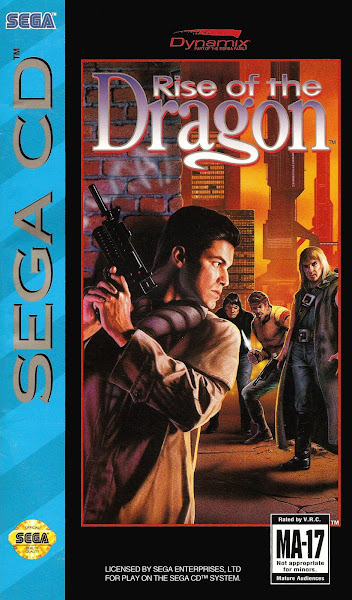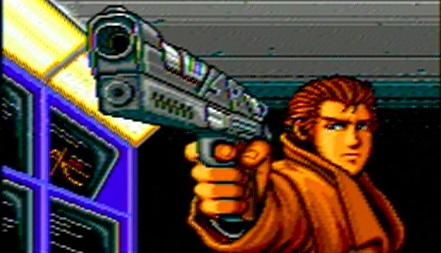
|
| Released in 1993 by Dynamix, Inc. and ported to the Sega CD by Game Arts, Rise of the Dragon is a graphic adventure game set in a dark, futuristic, cyberpunk world |
I recently played through the incredible Snatcher for the Sega CD. Once I finished and reviewed that great game, I didn't want to leave the realm of Sega CD cyberpunk graphic adventure. I kept hearing Rise of the Dragon mentioned in the same breath as Snatcher, so I decided to give it a try. Is Rise of the Dragon anywhere near Snatcher's league?

|
| Hmm..."Blade Hunter" sounds an awful lot like a certain Ridley Scott cyberpunk movie I love |
Nope. Rise of the Dragon has its moments, but contains several frustrating elements that sap the fun away. This 1993 game takes place in a 2053 Los Angeles that doesn't look much different from a slightly dystopian 1980's Los Angeles. The player takes control of William "Blade" Hunter, an ex-police officer, who now works as a private investigator. Blade is tasked by the mayor to investigate a deeply personal matter. Apparently, the mayor's hard-partying and rebellious daughter was experimenting with exotic substances, and died from a drug that mutated her into a horrid looking beast. Blade finds the Chinese Mafia was involved and must hit the streets looking for info...and also win back his angry girlfriend, Karen, who works at City Hall and can provide Blade with valuable info.

|
| Turns out the fate of the world rests on you getting this lady to chill the hell out |
On paper, this game should work. However, the execution is wanting. Rise of the Dragon is essentially a point-and-click adventure game. The player must pick up items for later use, solve puzzles, and navigate conversations with non-player characters to progress. An intuitive, well-designed interface is key in this type of game. It is immediately apparent that Rise of the Dragon's is neither intuitive, nor well-designed. The player must move a cursor around the screen, to navigate through an area, and to look for objects with which to interact. If the player grabs an item either from their inventory or that can be placed in inventory, but doesn't drag that item to their inventory, then accidentally leaves that area of the environment, the item leaves their inventory...sometimes permanently. And if that item is necessary to progress...the player can't progress. Yes, one wrong step, and Rise of the Dragon is hard-locked--there's NO WAY TO PROGRESS.

|
| Yep, that about sums it up |
Losing an item isn't the only way to suddenly render Rise of the Dragon unwinnable. Like most graphic adventure games from this era, conversations with non-player characters involve dialogue trees. Unlike most graphic adventure games from this era, telling an NPC the wrong thing can completely stop the player's ability to progress. The NPC will refuse to talk to you again, and there's literally no way to move on in the game. Rise of the Dragon does remind the player to frequently save, which can be done at any time, but the problem is, you don't alwas KNOW that you've made Rise of the Dragon unwinnable, and you might just save after you've done so...meaning your save file is basically a dead file. It's infuriating. Even with three save slots to back up your progress throughout, it's still tough to tell just where you went wrong...and naturally, this is one one of those games that gives absolutely no direction as to what you're supposed to be doing.

|
| That's all I was looking for with this game too, Blade |
As to the actual story, there's not really anything innovative or thematically deep here, just a drug lord intent on world domination. The only really futuristic element here is the mutagen drug. Most of the game's settings are dingy alleys and clubs that, as I've mentioned, just look like dingy 80's alleys and clubs. As for graphics, they're stylized and look pretty cool. The Sega CD version (this was originally a late 80's PC release) tints everything green, and while some players have reacted negatively to this, 90's sci-fi (and cyberpunk) did definitively climax with The Matrix in 1999, so I'm fine with it. As for sound, there's a lot of voice-acting, and it's overall not bad. I particularly enjoy the legendary Cam Clarke (Leonardo from TMNT, Kaneda from Akira, Liquid Snake in Metal Gear) as the snarky Blade. The music is hit and miss, a few solid tunes mixed in with some clunkers whose drum tracks sound like they're running into each other.

|
| I guess this could technically be Neo's apartment |
In a perfect world where certain random actions DIDN'T render Rise of the Dragon permanently unwinnable, I still don't think this would be a great game. Making progress is fun, but several of the puzzles aren't intuitive, and the game also features a timer that rushes experimentation. Yes, not only can you render the game unwinnable by making the wrong decision or losing an inventory item, but you can also run out of time! The joy from these types of games is generally in TAKING YOUR TIME, experimenting and trying to enjoy the world the game presents to the fullest. There are a few gnarly story branches in Rise of the Dragon the player can pursue and some big rewards for lateral thinking, but the time crunch, as well as the possibility of taking a dead end track you can't turn around from, discourages the player from ever discovering them!

|
| Let me into this game, game! |
Rise of the Dragon also attempts to throw a little variation at the player, by including several side-scrolling platformer segments into the game. Unfortunately, the controls for those segments are exceedingly clunky, and if the player hasn't done things absolutely as the game wanted early in, they're stuck using a lousy gun that makes these segments far more difficult (do things right, and you get a better one). There's also a first-person shooter moment here too that's not only a tiny blip in the overall gameplay, but easily missed if you don't take the longest possible path to the game's ending.
 |
| Side-scrolling blade maneuvers like a particularly unwieldy refrigerator |
Overall, I do appreciate the late 80's/early 90's cyberpunk vibe here, even though there's little imagination in the worldbuilding or futuristic elements. Rise of the Dragon does feature scattered moments that are quite enjoyable, but again, the game's flaws suck most of the fun away. After rendering the game unwinnable several times early in, I nervously looked to a strategy guide to get to the end of the game, just so I wouldn't brick my progress again. That's no way to have to play a game. With just a little more thought toward player experience, Rise of the Dragon could have been a minor genre classic. Instead, it's a frustrating misfire whose positive moments aren't quite plentiful enough to lift Rise of the Dragon to hidden gem status. For me, Rise of the Dragon is just a minor curio to alleviate my Snatcher comedown.
Graphics: 6.5/10.0
Sound: 6.5/10.0
Gameplay: 4.9/10.0
Lasting Value: 4.5/10.0
Overall (Not an Average): 5.5/10.0










